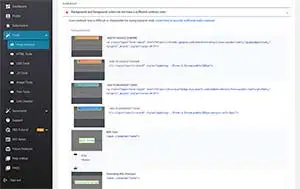How does A/B testing work?
A/B testing works by dividing website visitors into two or more groups and showing each group a different version of a webpage or element. One group is shown the original version (control), while the other group is shown a variant with one or more changes (variation). The performance of each version is then measured and compared based on predefined metrics, such as click-through rates, conversion rates, or time on page.
What are some elements that can be tested with A/B testing?
A/B testing can be used to test various elements of a webpage or digital asset, including:
1. Call-to-Action (CTA) Buttons: Testing different colors, sizes, text, or placements of CTA buttons to determine which ones drive more clicks and conversions.
2. Headlines and Copy: Testing different headlines, messaging, or copywriting styles to identify the most compelling and persuasive language.
3. Page Layouts: Testing different layouts, designs, or arrangements of content to optimize visual hierarchy and user flow.
4. Images and Media: Testing different images, videos, or multimedia elements to assess their impact on engagement and conversions.
Setting Up A/B Tests
Before you can start running A/B tests, you need to define the elements you want to test and set up a testing platform or tool.
Identify the specific elements on your website that you want to optimize, such as headlines, call-to-action buttons, or page layouts.
Next, choose a reliable A/B testing platform that allows you to create and run experiments easily.
Once you have selected your testing platform, set up the necessary tracking codes and implement the changes you want to test on your website.
Setting up A/B tests correctly is crucial to guarantee accurate results and reliable insights.
Optimizing Performance Through A/B Testing
A/B testing is a powerful technique for optimizing the performance of your website.
By testing different variations of your website elements, you can identify the ones that resonate best with your audience and lead to higher conversions.
Through A/B testing, you can uncover insights about user preferences, behavior, and preferences, allowing you to make data-driven decisions for improving your website.
Optimizing performance through A/B testing helps you maximize the impact of your website and achieve your business goals.
What is A/B testing, and how does it benefit website optimization?
A/B testing, also known as split testing, is a method used to compare two versions of a webpage or app to determine which one performs better in terms of user engagement or conversion rates. In A/B testing, users are randomly divided into two groups, with each group seeing a different version of the webpage or app (Version A and Version B). By analyzing user behavior and performance metrics, such as click-through rates or conversion rates, the effectiveness of each version can be assessed. A/B testing allows website owners or marketers to make data-driven decisions, optimize their websites or apps, and improve user experience, ultimately leading to higher conversion rates and better overall performance.
Mastering A/B Testing Techniques
To become proficient in A/B testing, it's essential to master the techniques and best practices.
Start by formulating hypotheses and identifying the key metrics you want to measure.
Design your experiments carefully, ensuring that you have a large enough sample size and that the test variations are properly randomized.
Analyze the results of your tests using statistical methods to determine the significance of the differences observed.
By mastering A/B testing techniques, you can guarantee accurate and reliable results that drive meaningful improvements on your website.
Analyzing Test Results
Analyzing test results is a critical step in the A/B testing process.
Examine the data collected during your experiments and analyze the performance metrics for each variation.
Look for statistically significant differences between the control and variant groups to determine which variation performed better.
Consider factors such as conversion rates, click-through rates, bounce rates, and other relevant metrics.
By analyzing test results, you can gain insights into user behavior and preferences, helping you make informed decisions for website optimization.
Implementing Changes
After analyzing the test results and identifying the winning variation, it's time to implement the changes on your website.
Use the insights gained from A/B testing to update the elements that performed better in the variant group.
Make sure to carefully track the impact of the implemented changes on your website's performance.
Monitor the metrics and compare them to the baseline to assess the effectiveness of the changes.
Implementing changes based on A/B testing results allows you to continuously optimize your website for better performance.
Advanced A/B Testing Strategies
Once you have mastered the basics of A/B testing, you can study advanced strategies to further optimize your website.
Consider conducting multivariate tests to test multiple variations of different elements simultaneously.
Segment your audience to target specific user groups and personalize the user experience based on their characteristics or behavior.
Study into different testing methodologies, such as sequential testing or bandit algorithms, to improve the efficiency and effectiveness of your A/B tests.
By adopting advanced A/B testing strategies, you can unloose new insights and drive continuous improvements on your website.










